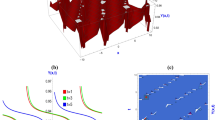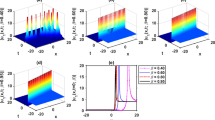Abstract
Previously, we developed a dynamic model for the tubuloglomerular feedback (TGF) system in a single, short-looped nephron of the mammalian kidney. In that model, a semi-linear hyperbolic partial differential equation was used to represent two fundamental processes of solute transport in the nephron’s thick ascending limb (TAL): chloride advection by fluid flow along the TAL lumen and transepithelial chloride transport from the lumen to the interstitium. An empirical function and a time delay were used to relate glomerular filtration rate to the chloride concentration at the macula densa of the TAL. Analysis of the model equations indicated that stable limit-cycle oscillations (LCO) in nephron fluid flow and chloride concentration can emerge for sufficiently large feedback gain magnitude and time delay. In this study, the single-nephron model was extended to two nephrons, which were coupled through their filtration rates. Explicit analytical conditions were obtained for bifurcation loci corresponding to two special cases: (1) identical time delays but differing feedback gains, and (2) identical gains but differing delays. Similar to the case of a single nephron, our analysis indicates that stable LCO can emerge in coupled nephrons for sufficiently large gains and delays. However, these LCO may emerge at lower values of the feedback gain, relative to a single (i.e., uncoupled) nephron, or at shorter delays, provided the delays are sufficiently close. These results suggest that, in vivo, if two nephrons are sufficiently similar, then coupling will tend to increase the likelihood of LCO.
Similar content being viewed by others
References
Andersen, M. D., N. Carlsson, E. Mosekilde and N.-H. Holstein-Rathlou (2002). Dynamic model of nephron-nephron interaction, in Membrane Transport and Renal Physiology, The IMA Volumes in Mathematics and its Applications 129, H. E. Layton and A. M. Weinstein (Eds), New York: Springer, pp. 365–391.
Barfred, M., E. Mosekilde and N.-H. Holstein-Rathlou (1996). Bifurcation analysis of nephron pressure and flow regulation. Chaos 6, 280–287.
Briggs, J. (1982). A simple steady-state model for feedback control of glomerular filtration rate. Kidney Int. 22(Suppl. 12), S143–S150.
Casellas, D., M. Dupont, N. Bouriquet, L. C. Moore, A. Artuso and A. Mimran (1994). Anatomic pairing of afferent arterioles and renin cell distribution in rat kidneys. Am. J. Physiol. 267 (Renal Fluid Electrolyte Physiol. 36), F931–F936.
Casellas, C. and L. C. Moore (1990). Autoregulation and tubuloglomerular feedback in juxtamedullary glomerular arterioles. Am. J. Physiol. 258 (Renal Fluid Electrolyte Physiol. 27), F660–F669.
Chen, Y.-M, K.-P. Yip, D. J. Marsh and N.-H. Holstein-Rathlou (1995). Magnitude of TGF-initiated nephron-nephron interaction is increased in SHR. Am. J. Physiol. 269 (Renal Fluid Electrolyte Physiol. 38), F198–F204.
Cupples, W. A., P. Novak, V. Novak and F. C. Salevsky (1996). Spontaneous blood pressure fluctuations and renal blood flow dynamics. Am. J. Physiol. 270 (Renal Fluid Electrolyte Physiol. 39), F82–F89.
Holstein-Rathlou, N.-H. (1987). Synchronization of proximal intratubular pressure oscillations: evidence for interaction between nephrons. Pflügers Arch. 408, 438–443.
Holstein-Rathlou, N.-H. (1991). A closed-loop analysis of the tubuloglomerular feedback mechanism. Am. J. Physiol. 261 (Renal Fluid Electrolyte Physiol. 30), F880–F889.
Holstein-Rathlou, N.-H. and P. P. Leyssac (1986). TGF-mediated oscillations in proximal intratubular pressure: differences between spontaneously hypertensive rats and Wistar-Kyoto rats. Acta Physiol. Scand. 126, 333–339.
Holstein-Rathlou, N.-H. and P. P. Leyssac (1987). Oscillations in the proximal intratubular pressure: a mathematical model. Am. J. Physiol. 252 (Renal Fluid Electrolyte Physiol. 21), F560–F572.
Holstein-Rathlou, N.-H. and D. J. Marsh (1989). Oscillations of tubular pressure, flow, and distal chloride concentration in rats. Am. J. Physiol. 256 (Renal Fluid Electrolyte Physiol. 25), F1007–F1014.
Holstein-Rathlou, N.-H. and D. J. Marsh (1990). A dynamic model of the tubuloglomerular feedback mechanism. Am. J. Physiol. 258 (Renal Fluid Electrolyte Physiol. 27), F1448–F1459.
Holstein-Rathlou, N.-H. and D. J. Marsh (1994). A dynamic model of renal blood flow autoregulation. Bull. Math. Biol. 56, 411–430.
Just, A., U. Wittmann, H. Ehmke and H. R. Kirchheim (1998). Autoregulation of renal blood flow in the conscious dog and the contribution of the tubuloglomerular feedback. J. Physiol. 506.1, 275–290.
Källskog, Ö. and D. J. Marsh (1990). TGF-initiated vascular interactions between adjacent nephrons in the rat kidney. Am. J. Physiol. 259 (Renal Fluid Electrolyte Physiol. 28), F60–F64.
Layton, H. E. and E. B. Pitman (1994). A dynamic numerical method for models of renal tubules. Bull. Math. Biol. 56, 547–565.
Layton, H. E., E. B. Pitman and L. C. Moore (1991). Bifurcation Analysis of TGF-mediated oscillations in SNGFR. Am. J. Physiol. 261 (Renal Fluid Electrolyte Physiol. 30), F904–F919.
Layton, H. E., E. B. Pitman and L. C. Moore (1995). Instantaneous and steady-state gains in the tubuloglomerular feedback system. Am. J. Physiol. 268 (Renal Fluid Electrolyte Physiol. 37), F163–F174.
Layton, H. E., E. B. Pitman and L. C. Moore (1997a). Nonlinear filter properties of the thick ascending limb. Am. J. Physiol. 273 (Renal Physiol. 42), F625–F634.
Layton, H. E., E. B. Pitman and L. C. Moore (1997b). Spectral properties of the tubuloglomerular feedback system. Am. J. Physiol. 273 (Renal Physiol. 42), F635–F649.
Layton, H. E., E. B. Pitman and L. C. Moore (2000). Limit-cycle oscillations and tubuloglomerular feedback regulation of distal sodium delivery. Am. J. Physiol. Renal Physiol. 278, F287–F301.
Leyssac, P. P. (1986). Further studies on oscillating tubulo-glomerular feedback responses in the rat kidney. Acta Physiol. Scand. 126, 271–277.
Leyssac, P. P. and L. Baumbach (1983). An oscillating intratubular pressure response to alterations in Henle flow in the rat kidney. Acta Physiol. Scand. 117, 415–419.
Oldson, D. R., L. C. Moore and H. E. Layton (2003). Effect of sustained flow perturbations on stability and compensation of tubuloglomerular feedback. Am. J. Physiol. Renal Physiol. 285, F972–F989.
Pitman, E. B., H. E. Layton and L. C. Moore (1993). Dynamic flow in the nephron: filtered delay in the TGF pathway. Contemp. Math. 141, 317–336.
Pitman, E. B., R. M. Zaritski, L. C. Moore and H. E. Layton (2002). A reduced model for nephron flow dynamics mediated by tubuloglomerular feedback, in Membrane Transport and Renal Physiology, The IMA Volumes in Mathematics and its Applications 129, H. E. Layton and A. M. Weinstein (Eds), New York: Springer, pp. 345–364.
Ren, Y., O. A. Carretero and J. L. Garvin (2002). Role of mesangial cells and gap junctions in tubuloglomerular feedback. Kidney Int. 62, 525–531.
Schnermann, J. and J. P. Briggs (2000). Function of the juxtaglomerular apparatus: control of glomerular hemodynamics and renin secretion, in The Kidney: Physiology and Pathophysiology, 3rd edn., D. W. Seldin and G. Giebisch (Eds), Philadelphia: Lippincott Williams & Wilkins, pp. 945–980.
Sosnovtseva, O. V., D. E. Postnov, E. Mosekilde and N.-H. Holstein-Rathlou (2003). Synchronization of tubular pressure oscillations in interacting nephrons. Chaos Solitons Fractals 15, 343–369.
Vander, A. J. (1995). Renal Physiology, New York: McGraw-Hill.
Wagner, A. J., N.-H. Holstein-Rathlou and D. J. Marsh (1997). Internephron coupling by conducted vasomotor responses in normotensive and spontaneously hypertensive rats. Am. J. Physiol. 272 (Renal Physiol. 41), F372–F379.
Yip, K.-P., N.-H. Holstein-Rathlou and D. J. Marsh (1991). Chaos in blood flow control in genetic and renovascular hypertensive rats. Am. J. Physiol. 261 (Renal Fluid Electrolyte Physiol. 30), F400–F408.
Yip, K.-P., N.-H. Holstein-Rathlou and D. J. Marsh (1992). Dynamics of TGF-initiated nephron-nephron interactions in normotensive rats and SHR. Am. J. Physiol. 262 (Renal Fluid Electrolyte Physiol. 31), F980–F988.
Author information
Authors and Affiliations
Corresponding author
Rights and permissions
About this article
Cite this article
Pitman, E.B., Zaritski, R.M., Kesseler, K.J. et al. Feedback-mediated dynamics in two coupled nephrons. Bull. Math. Biol. 66, 1463–1492 (2004). https://doi.org/10.1016/j.bulm.2004.01.006
Received:
Accepted:
Issue Date:
DOI: https://doi.org/10.1016/j.bulm.2004.01.006




